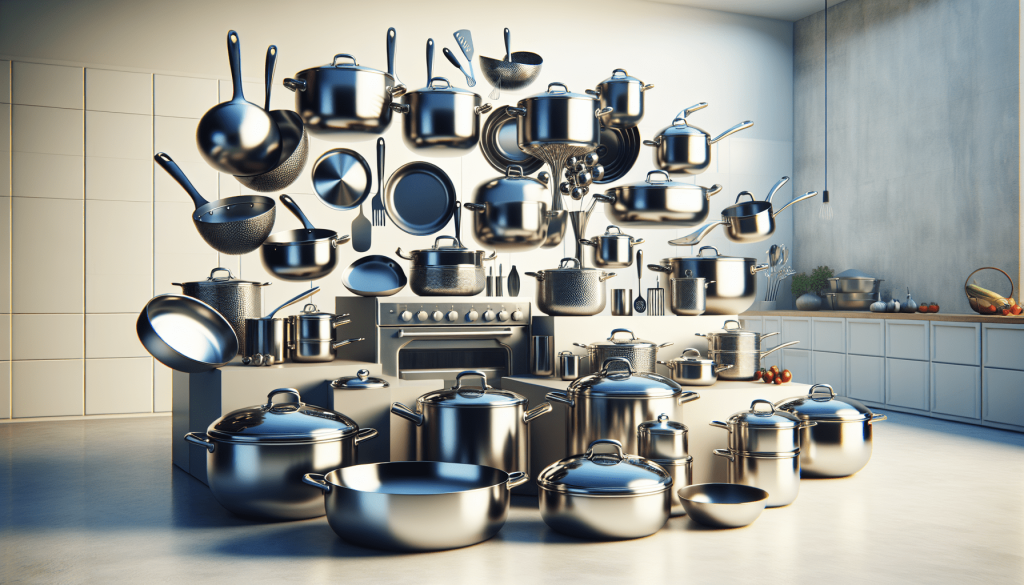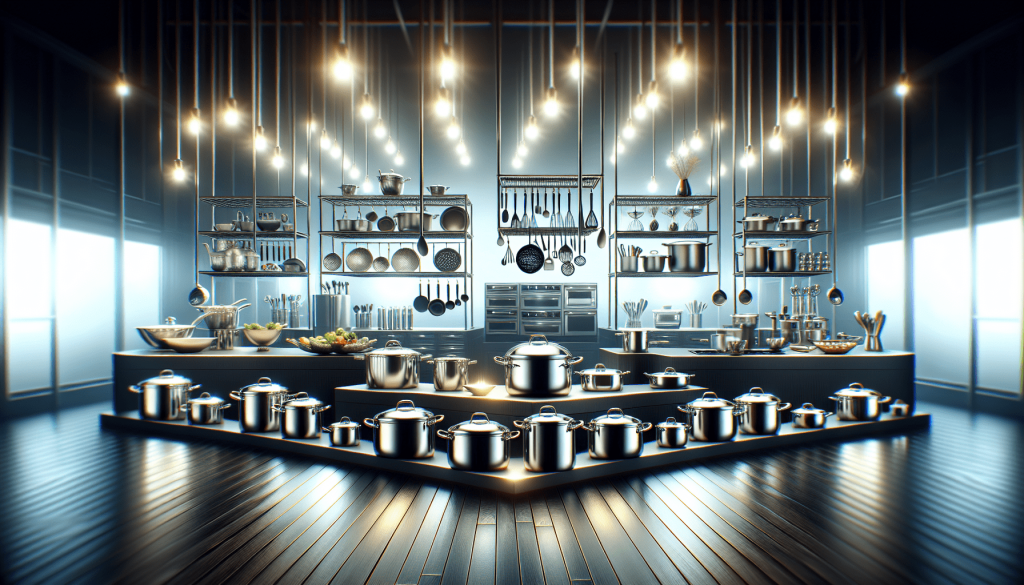So you’re on a mission to upgrade your kitchen and find the perfect cookware that suits your culinary needs? Look no further! In this ultimate guide, we’ll navigate through the world of cookware to help you make the best choices for your kitchen. From exploring different types of materials, understanding their benefits and drawbacks, to considering factors like heat conductivity and maintenance, we’ve got you covered. Get ready to take your cooking game to the next level with the best cookware that will inspire you to create delicious dishes every time you step into your kitchen. Let’s get started!

Material
When it comes to choosing cookware for your kitchen, the material is an important factor to consider. Each material has its own unique properties and advantages. Let’s take a closer look at four popular options: stainless steel, cast iron, non-stick, and copper.
Stainless Steel
Stainless steel cookware is a staple in many kitchens for good reason. It is known for its durability and resistance to wear and tear. Stainless steel pots and pans can withstand high heat and are less likely to warp or dent over time. This makes them a great investment that will last for years to come. Additionally, stainless steel is non-reactive with food, meaning it won’t leach any unwanted flavors or chemicals into your meals.
Cast Iron
Cast iron cookware is renowned for its excellent heat retention and even heat distribution. These qualities make it ideal for slow cooking and braising. Cast iron pans and Dutch ovens are fantastic for achieving a deep and rich sear on meats, creating a delicious caramelization. While cast iron requires a bit of maintenance and seasoning, it can develop a natural non-stick surface over time with proper care.
Non-stick
Non-stick cookware has become increasingly popular for its convenience and ease of cleaning. The non-stick surface allows for food to slide off effortlessly, reducing the need for excessive oil or fat. This makes it a great option for those looking for healthier cooking methods. However, non-stick pans are not as durable as other materials and may wear out over time, especially if used with metal utensils. It’s important to follow the manufacturer’s instructions and treat them with care to ensure longevity.
Copper
Copper cookware is known for its excellent heat conductivity and responsiveness to temperature changes. This means that it heats up quickly and evenly, allowing for precise control over cooking temperatures. Copper pans are highly versatile and can be used on various stovetop types, including gas, electric, and induction. However, copper is a reactive material and can interact with certain foods, resulting in a metallic taste. To avoid this, copper cookware is often lined with a layer of stainless steel or tin.
Durability
When investing in cookware, it’s important to consider its durability. You want pots and pans that will withstand the test of time and resist wear and tear.
Longevity
Stainless steel and cast iron cookware are known for their long-lasting durability. They can endure high heat and are less likely to dent or warp. With proper care, these materials can last for generations, making them a worthwhile investment.
Resistance to Wear and Tear
Non-stick cookware, while convenient, may have a shorter lifespan compared to stainless steel or cast iron. The non-stick coating can wear off over time, especially if metal utensils are used or if it’s subjected to high heat. Copper cookware can also be prone to scratches and dents, so it requires careful handling to maintain its longevity.
Heat Conductivity
The ability of cookware to conduct heat evenly and respond to temperature changes is crucial for achieving optimal cooking results.
Even Heat Distribution
Cast iron and stainless steel both excel in distributing heat evenly. This ensures that your food cooks uniformly, without any hotspots. This is especially important for delicate dishes that require precise heat control.
Response to Temperature Changes
Copper cookware is known for its responsiveness to temperature changes. It heats up quickly and cools down rapidly, allowing for immediate adjustments in cooking temperature. This level of control is ideal for tasks such as searing or sautéing, where precise temperature changes are necessary.
Maintenance
Taking care of your cookware is essential for prolonging its lifespan and ensuring optimal performance.
Ease of Cleaning
Non-stick cookware is the easiest to clean, thanks to its non-stick surface. Food slides off effortlessly, and a simple wash with warm, soapy water is usually sufficient. Stainless steel and cast iron can require more scrubbing, especially if food is stuck to the surface. However, many stainless steel pots and pans are dishwasher-safe, making cleaning a breeze.
Compatibility with Dishwasher
While some cookware is dishwasher-safe, it’s important to check the manufacturer’s instructions. Copper cookware, for example, is best washed by hand to maintain its luster and prevent tarnishing.
Seasoning Requirements
Cast iron cookware requires seasoning to develop a natural non-stick surface. This involves coating the pan with cooking oil and heating it in the oven. Regular seasoning helps prevent rust and maintains the pan’s non-stick properties.

Versatility
Having cookware that can be used on different stovetop types and is oven-safe increases its versatility in the kitchen.
Ability to Use on Different Stovetop Types
Stainless steel, cast iron, and non-stick cookware are compatible with various stovetop types, including gas, electric, and induction. This versatility allows you to use them regardless of the type of stove you have in your kitchen.
Oven-Safe Compatibility
Some cookware, especially those with non-metal handles or coatings, may not be suitable for use in the oven. However, many stainless steel and cast iron pots and pans are oven-safe, allowing you to easily transition from stovetop to oven for certain dishes.
Price
The price of cookware can vary greatly depending on the material and brand. It’s important to find options that fit your budget while still offering good value for money.
Budget-Friendly Options
Stainless steel cookware is often more affordable compared to cast iron or copper. Non-stick cookware can also be budget-friendly, especially if you choose mid-range options that offer a good balance between quality and price.
Value for Money
When considering the price, it’s important to also evaluate the quality and durability of the cookware. Investing in high-quality stainless steel or cast iron cookware may be more expensive upfront, but their longevity and performance make them excellent value for money in the long run.
Cooking Performance
Cooking performance is a crucial aspect to consider when choosing cookware. Different materials offer varying heat retention, non-reactivity with food, and browning and searing capabilities.
Heat Retention
Cast iron and copper excel in heat retention, allowing them to evenly distribute heat and maintain a consistent temperature. This is beneficial for dishes that require slow cooking or simmering for extended periods.
Non-Reactivity with Food
Stainless steel is non-reactive with food, making it a safe and reliable choice for cooking various ingredients. Cast iron, once properly seasoned, also offers non-reactivity, although acidic foods may impact the seasoning. Copper cookware, on the other hand, can react with certain foods, altering the taste and appearance of the dish.
Browning and Searing Capabilities
Cast iron and stainless steel are excellent at achieving a beautiful golden-brown sear on meats and achieving caramelization on vegetables. Their ability to retain heat and distribute it evenly helps achieve consistent browning, adding flavor and texture to your dishes.
Size and Weight
When choosing cookware, it’s important to consider the size and weight that best suits your cooking needs and preferences.
Suitability for Your Cooking Needs
Consider the size of your typical meals and the number of people you cook for. Pots and pans that are too small may limit your cooking capabilities, while oversized ones may lead to inefficient heat distribution. Choose sizes that match your needs for optimal cooking performance.
Ease of Handling and Storage
Weight is an important consideration as well, especially if you have limited upper body strength or prefer lightweight cookware. Stainless steel is generally lighter than cast iron and copper, making it easier to handle and store.
Safety
Ensuring that your cookware is safe to use is paramount, both for your health and peace of mind.
Handles with Heat Resistance
Heat-resistant handles are essential to protect yourself from burns during cooking. Many cookware options come with handles made from materials such as silicone or stainless steel that stay cool to the touch even when subjected to high temperatures.
Non-Toxic Materials
It’s important to choose cookware made from non-toxic materials to ensure that no harmful substances leach into your food. Stainless steel, cast iron, and copper are all safe options, free from harmful coatings or chemicals.
Brand Reputation
Considering the reputation of the brand and customer feedback can give you insight into the quality and performance of the cookware you are considering.
Customer Reviews and Ratings
Take the time to read customer reviews and ratings for different cookware brands. This can give you an idea of their durability, performance, and customer satisfaction. Look for brands with consistently positive feedback.
Warranty and Customer Support
A reputable brand will often offer a warranty and have excellent customer support. This provides peace of mind, knowing that you can reach out if any issues arise with your cookware.
When choosing the best cookware for your kitchen, consider the material, durability, heat conductivity, maintenance, versatility, price, cooking performance, size and weight, safety, and brand reputation. By carefully evaluating each of these factors based on your individual needs, preferences, and budget, you can make an informed decision and invest in cookware that will enhance your cooking experience for years to come.
